26th August, 2025

Mar 18, 2024
Mera Peak Climbing in December
- Is Mera Peak difficult to climb?
- Can a beginner climb Mera Peak?
- Can you climb Mount Everest in December?
- Is Mera Peak harder than Kilimanjaro?
- Weather during Mera Peak Climbing In December:
- Climate during Mera Peak Climbing December
- Lukla Flight in December
- Can you see Mt. Everest from Mera Peak?
- How dangerous is Mera Peak?
- Mera Peak vs. Island Peak, which one is easier to climb?
- Can I climb Mera Peak as I’m a novice climber?
- Weather during Mera Peak Climbing In December
- What Should I Pack For Mera Peak Climb
- Highlights of Mera Peak
- Tips for Successful Mera Peak Climb
- Altitude Sickness and Acclimatization in December
- Final Say
- Mera Peak Climbing Packages
Climbing Mera Peak in December offers a unique adventure amidst Nepal's winter season, providing both challenges and rewards for trekkers and climbers. Standing at 6,476 meters (21,246 feet), Mera Peak is Nepal's highest trekking peak, renowned for its stunning views of Everest, Lhotse, Makalu, and other Himalayan giants.
December marks the onset of winter in Nepal, bringing colder temperatures and drier weather conditions. While the days are crisp and clear, the nights can be bitterly cold, requiring climbers to pack and prepare accordingly with warm clothing and proper gear. The advantage of December climbing lies in the clear skies and reduced precipitation, offering excellent visibility and panoramic vistas of the surrounding peaks from Mera Peak's summit.
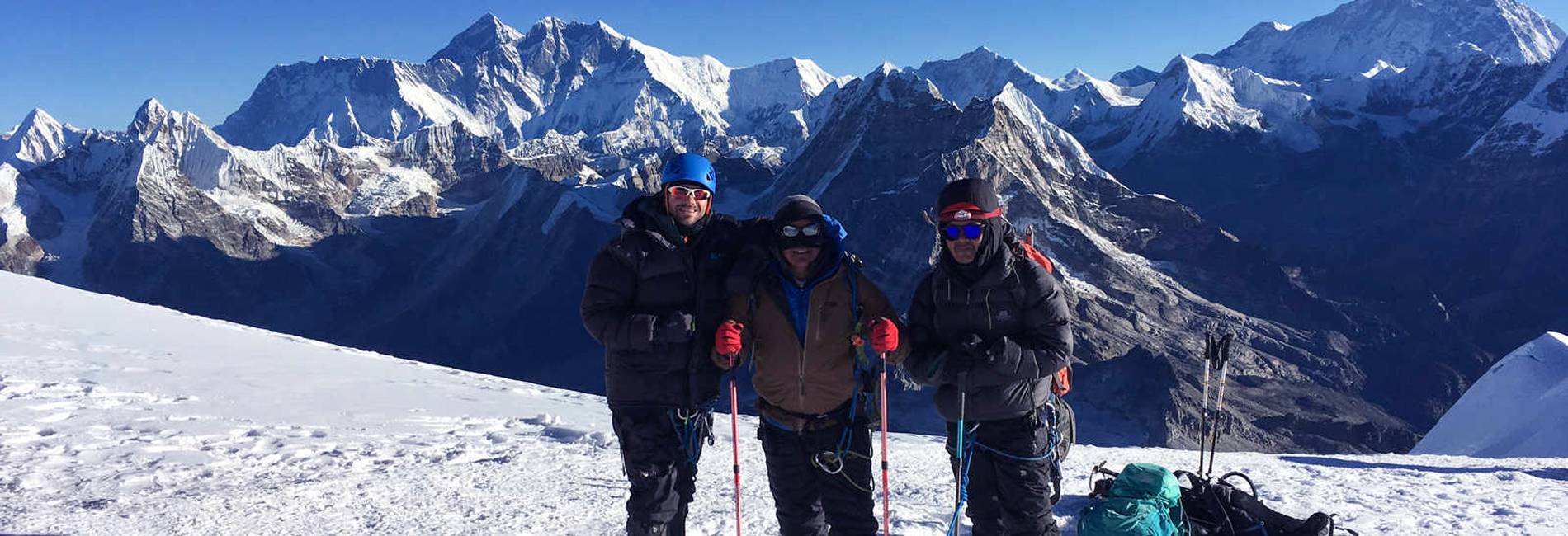
MERA PEAK CLIMBING
Mera Peak Climbing is an exhilarating adventure in Nepal that gives you an opportunity to reach the summit of Mera Peak at more than 6400m above sea level. Actually, it is the highest climbing (w...
The trek to Mera Peak typically begins with a flight to Lukla followed by a trek through picturesque Sherpa villages and dense forests. As climbers ascend, the landscape transforms into alpine terrain, eventually leading to Mera Peak Base Camp and High Camp. Sherpa guides, renowned for their expertise and local knowledge, accompany climbers throughout the journey, ensuring safety and providing insights into the region's culture and traditions.
Summit day on Mera Peak involves an early start to catch the sunrise and enjoy breathtaking views from the summit. The climb itself is non-technical but requires physical endurance and acclimatization due to the altitude. Climbers should be prepared for icy conditions and use of crampons and ice axes during the ascent.
Choosing December for Mera Peak climbing offers a quieter trekking experience compared to peak seasons, with fewer climbers on the trail. It's essential to be well-prepared for cold weather and potential snowfall, making safety and comfort top priorities. Overall, climbing Mera Peak in December promises an unforgettable adventure for those seeking solitude, stunning vistas, and the thrill of summiting a Himalayan peak in winter.

MERA PEAK CLIMBING 17 DAYS
This is an excellent opportunity to climb Nepal’s highest peak without having to obtain a permit (6,476m/21,190ft). From the summit, you will have stunning views of several 8000m plus peaks, such as E...
Is Mera Peak difficult to climb?
Climbing Mera Peak is considered challenging but achievable for climbers with proper preparation and experience. As Nepal's highest trekking peak at 6,476 meters (21,246 feet), Mera Peak requires physical fitness, stamina, and the ability to acclimatize to high altitudes. The climb itself is non-technical, involving trekking through varied terrain including glaciers and snow slopes. However, climbers must be prepared for cold temperatures, altitude sickness risks, and occasional challenging weather conditions. With the guidance of experienced Sherpa guides and a well-structured itinerary that includes acclimatization days, many climbers successfully reach Mera Peak's summit each year.
Can a beginner climb Mera Peak?
While Mera Peak is suitable for climbers with basic mountaineering skills and fitness, it is generally not recommended for complete beginners. Climbers attempting Mera Peak should have prior experience trekking at high altitudes and familiarity with using crampons, ice axes, and other basic mountaineering equipment. Adequate physical preparation, including cardiovascular training and strength exercises, is essential. Choosing a reputable trekking agency like Sherpa Expedition, which provides experienced guides and comprehensive support, can significantly enhance a beginner's chances of a successful ascent. Beginners should also prioritize proper acclimatization and heed the guidance of their Sherpa guides to mitigate risks and maximize enjoyment of the climb.

MERA PEAK CLIMBING 15 DAYS
The Mera Peak Expedition is a 15-day trek that takes you through some of the most stunning landscapes and challenging trails in Nepal. Mera Peak is the highest trekking peak in Nepal, standing at 6,47...
Can you climb Mount Everest in December?
December is not a typical climbing season for Mount Everest due to harsh weather conditions, extreme cold, high winds, and reduced visibility. Most expeditions to Mount Everest occur during the spring (April-May) and autumn (September-October) seasons when weather and climbing conditions are more favorable. Climbing Everest in December presents significant challenges, including increased risk of frostbite, avalanches, and limited access to base camps due to snow-covered trails. Expeditions during this time are rare and typically involve highly experienced climbers and mountaineering teams equipped for extreme winter conditions. As such, climbers aspiring to summit Everest are advised to plan their expeditions during the established spring and autumn climbing seasons for safer and more feasible attempts.
Is Mera Peak harder than Kilimanjaro?
Comparing Mera Peak and Kilimanjaro involves considering different factors such as altitude, technical difficulty, and environmental conditions. Mera Peak, located in the Himalayas, reaches 6,476 meters (21,246 feet) and involves trekking through snow and glaciers, requiring basic mountaineering skills and acclimatization to high altitudes. The climb is physically demanding but considered non-technical.
In contrast, Kilimanjaro, Africa's highest peak at 5,895 meters (19,341 feet), is a non-technical trekking peak. It involves hiking through varied ecosystems, including rainforests, alpine meadows, and barren landscapes. The challenge on Kilimanjaro lies in altitude acclimatization and endurance over several days of trekking.
While both peaks present challenges, Mera Peak's higher altitude and colder conditions make it more physically demanding and technically challenging than Kilimanjaro. However, climbers with appropriate preparation and experience can successfully summit both peaks, each offering unique cultural and scenic experiences in their respective regions.

MERA PEAK EXPEDITION 14 DAYS
The Mera Peak Expedition is a 14-day trek that offers a unique and challenging route to the summit of Mera Peak. The Upper Route is a less-traveled path that takes you through some of the most remote...
Weather during Mera Peak Climbing In December:
December marks the onset of winter in Nepal, and weather conditions during Mera Peak climbing can be challenging. Expect cold temperatures, particularly at higher altitudes, with daytime temperatures ranging from freezing to below zero Celsius (32°F to 14°F). Nighttime temperatures can drop significantly, requiring warm clothing and proper gear to stay comfortable. The weather in December is generally dry, with occasional snowfall adding to the scenic beauty but potentially increasing the difficulty of the trek. It's essential to be well-prepared for cold weather conditions and to monitor forecasts closely for any changes that may affect the climb.
Climate during Mera Peak Climbing December
The climate during Mera Peak climbing in December is characterized by cold temperatures and dry weather. Days are typically clear with blue skies, providing excellent visibility for trekking and summit attempts. Nights are cold, often dropping below freezing at higher elevations. The climate becomes progressively colder as climbers ascend towards Mera Peak's summit. While December offers relatively stable weather compared to the monsoon season, climbers should still be prepared for sudden weather changes, including snowfall, which can affect trail conditions and visibility. Choosing appropriate clothing layers and gear, along with following guidance from experienced Sherpa guides, is crucial for navigating the climate challenges of December climbing on Mera Peak.
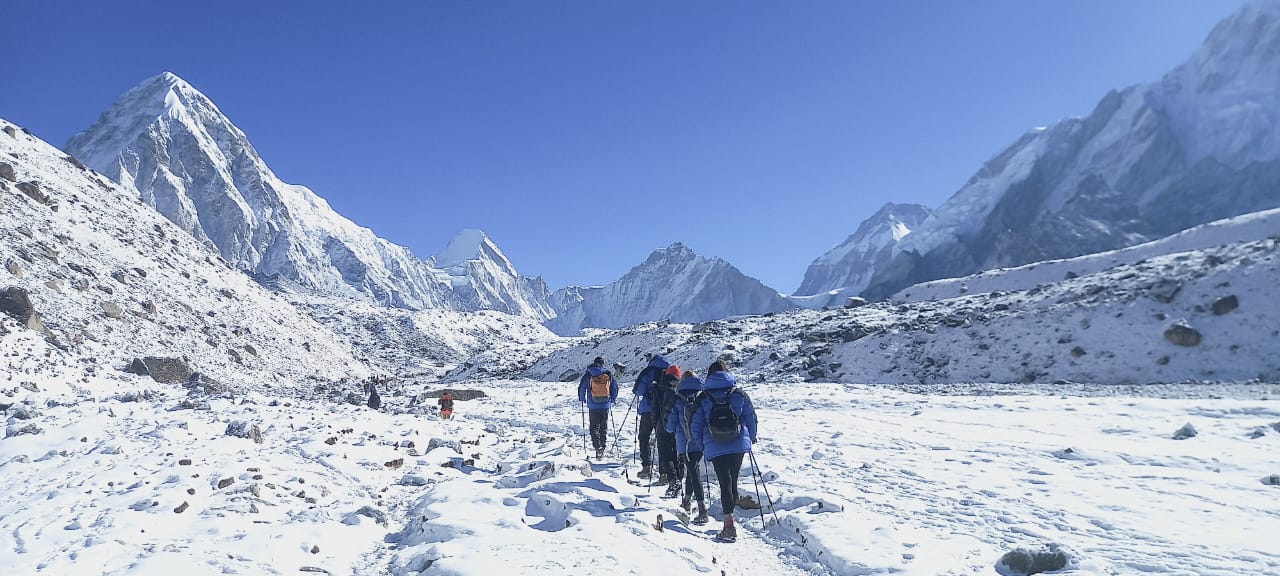
MERA AND ISLAND PEAK CLIMBING
Embark on a thrilling mountaineering adventure like no other with the Mera and Island Peak Climbing expedition crafted by We Sherpa Expedition and Trekking. This exclusive package is designed for adve...
Lukla Flight in December
Flying to Lukla in December involves navigating weather conditions typical of Nepal's winter season. While December offers clearer skies compared to the monsoon months, flights to Lukla can still be affected by occasional weather disturbances, including fog and wind. It's advisable to monitor flight schedules closely and be prepared for potential delays due to weather conditions. Airlines operating flights to Lukla prioritize safety, and delays may occur to ensure safe takeoff and landing in mountainous terrain. Travelers should maintain flexibility in their travel plans and consider booking flights with reputable airlines that prioritize safety and have experience operating in Nepal's mountainous regions during winter.
Can you see Mt. Everest from Mera Peak?
Yes, climbers summiting Mera Peak are rewarded with breathtaking views of Mount Everest (8,848 meters / 29,029 feet), the highest peak in the world. From Mera Peak's summit at 6,476 meters (21,246 feet), climbers enjoy panoramic vistas of Everest along with other prominent Himalayan peaks such as Lhotse, Makalu, and Kanchenjunga. On clear days, the sunrise from Mera Peak offers a spectacular view of the Himalayan range, making the climb a memorable experience for adventurers seeking stunning mountain scenery.
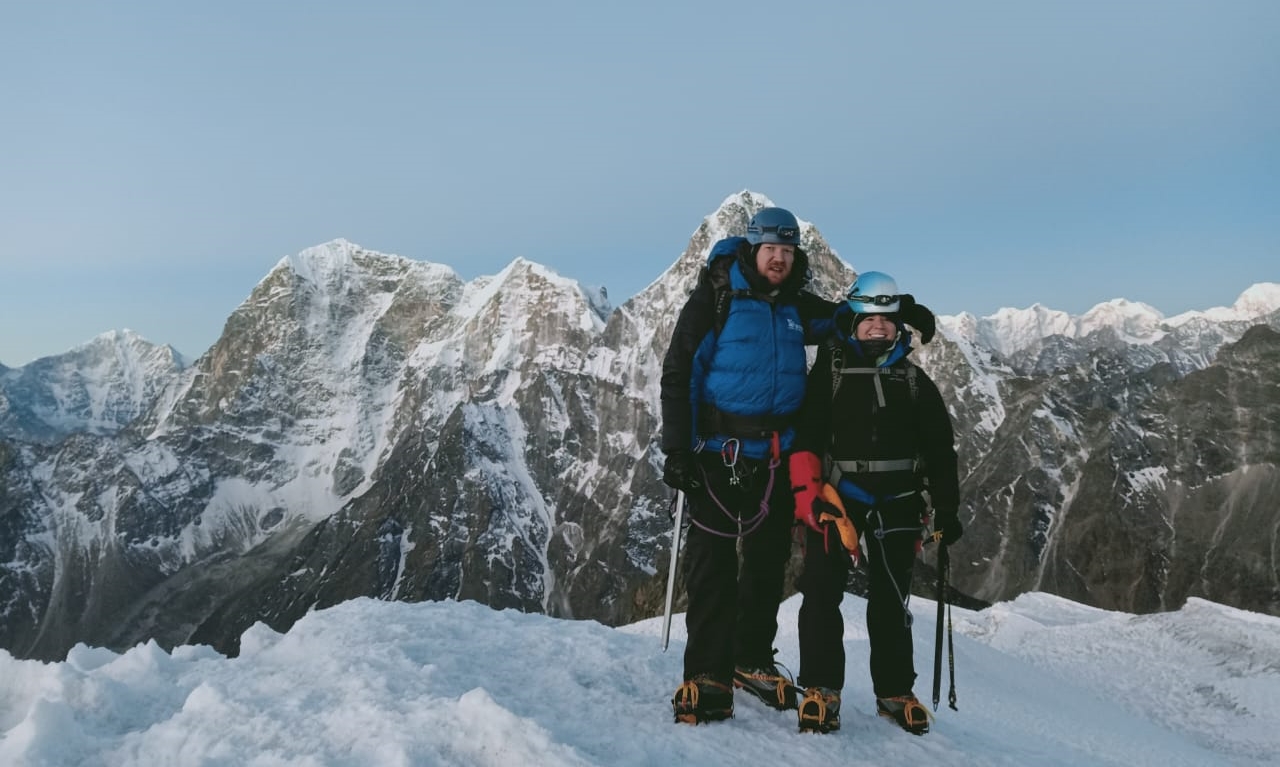
LOBUCHE PEAK CLIMBING
Lobuche East (6,119m/20,075ft), set in Nepal's stunning Khumbu on the Nepalese side of Everest.The best time to go trekking in Nepal is in Autumn (September-November) and in...
How dangerous is Mera Peak?
Mera Peak is considered a challenging but generally safe climb when approached with proper preparation, experienced guides, and adherence to safety protocols. The primary risks associated with climbing Mera Peak include altitude sickness, variable weather conditions, and physical exertion at high altitudes. Adequate acclimatization, physical fitness, and familiarity with basic mountaineering skills are essential for mitigating these risks. Sherpa guides, renowned for their expertise in Himalayan mountaineering, play a crucial role in ensuring safety, providing guidance, and monitoring climbers' health throughout the expedition. With careful planning, appropriate gear, and experienced guidance, climbers can safely enjoy the adventure and achievement of summiting Mera Peak.
Mera Peak vs. Island Peak, which one is easier to climb?
Comparing Mera Peak and Island Peak involves considering different factors such as altitude, technical difficulty, and terrain. Mera Peak, at 6,476 meters (21,246 feet), is Nepal's highest trekking peak and involves trekking through snow and glaciers with basic mountaineering skills required. The climb is non-technical but physically demanding due to altitude and terrain challenges.
In contrast, Island Peak (Imja Tse) stands at 6,189 meters (20,305 feet) in the Everest region and requires more technical climbing skills, including using fixed ropes, traversing crevasses, and ascending steep ice and rock faces. Island Peak is often chosen by climbers seeking to advance their mountaineering skills beyond basic trekking peaks like Mera Peak.
While both peaks present challenges, Mera Peak is generally considered less technical and more accessible for climbers with basic mountaineering experience. Island Peak requires proficiency in technical climbing techniques and may be more suitable for climbers seeking a greater challenge in the Everest region.

LOBUCHE PEAK SUMMIT RETURN BY HELICOPTER
A real climbing adventure that will leave you stunned at the beauty of the Himalayan Mountains. The Lobuche Peak Climbing expedition in the spectacular Khumbu region of Nepal has been ranked by Lonely...
Can I climb Mera Peak as I’m a novice climber?
Climbing Mera Peak as a novice climber is possible with proper preparation, physical fitness, and guidance from experienced Sherpa guides. While Mera Peak is considered suitable for climbers with basic mountaineering skills and high-altitude trekking experience, it is essential to undergo training and acclimatization before attempting the ascent. Novice climbers should focus on building endurance through cardiovascular exercises, strength training for muscle preparation, and familiarizing themselves with basic mountaineering equipment like crampons and ice axes.
Choosing a reputable trekking agency like Sherpa Expedition ensures access to experienced guides who provide training, support, and safety measures throughout the climb. They tailor itineraries to include gradual acclimatization and ensure climbers are well-equipped for the challenges of Mera Peak. With determination, preparation, and guidance, novice climbers can successfully summit Mera Peak, enjoying the stunning views and sense of achievement that come with conquering one of Nepal's highest trekking peaks.
Weather during Mera Peak Climbing In December
December brings winter to Nepal, affecting weather conditions on Mera Peak. Expect cold temperatures throughout the trek, especially at higher elevations. Daytime temperatures can range from freezing to slightly above freezing, while nighttime temperatures drop significantly below freezing. The weather is generally dry with occasional snowfall, which can affect trail conditions and visibility. Clear skies during the day provide excellent trekking conditions, but climbers should prepare for cold and potentially harsh weather, including high winds and icy terrain. Proper clothing layers, including insulated jackets, thermal base layers, hats, gloves, and waterproof gear, are essential to stay warm and dry.

ISLAND PEAK CLIMBING
Sherpa Expedition & Trekking (Est.1977) are pleased to announce FOR ADVENTURERS the most awesome, exhilarating & unforgettable climbing and treks on offer anywhere today!...
What Should I Pack For Mera Peak Climb
Packing for Mera Peak climb in December requires careful consideration of the cold weather and variable conditions typical of Nepal's winter season. Essential items include:
- Clothing: Insulated down jacket, thermal base layers, fleece jackets, waterproof and windproof outer layers, trekking pants, gloves, hats, and neck gaiters.
- Footwear: Sturdy trekking boots with good ankle support, waterproof and insulated for warmth.
- Gear: Sleeping bag rated for sub-zero temperatures, crampons, ice axe, harness, helmet, trekking poles, and headlamp with extra batteries.
- Miscellaneous: Sunglasses with UV protection, sunscreen, lip balm, toiletries, first aid kit, and personal medications.
- Food and Hydration: High-energy snacks, hydration bladder or water bottles, and water purification tablets.
- Documents: Passport, permits, and insurance documents in a waterproof pouch.
Packing light yet adequately ensures comfort and safety during the challenging trek and summit attempt on Mera Peak.
Highlights of Mera Peak
Mera Peak offers unforgettable highlights for climbers seeking a Himalayan adventure. Highlights include:
- Panoramic Views: Stunning vistas of Everest, Lhotse, Makalu, and Kanchenjunga from the summit.
- Cultural Experience: Trekking through Sherpa villages, experiencing local hospitality and traditions.
- Varied Terrain: Trekking through dense forests, rhododendron blooms (depending on altitude), alpine meadows, and glacier-covered landscapes.
- Challenging Climb: Non-technical ascent with glacier crossings and snow slopes, suitable for climbers with basic mountaineering skills.
- Sense of Achievement: Summiting one of Nepal's highest trekking peaks and enjoying the serene mountain environment.

ISLAND PEAK SUMMIT RETURN BY HELICOPTER
Many of us only dream of standing on a tall peak looking down on the world. This is a great climb that will satisfy this desire. Island Peak, also referred to as Imja Tse, is a 6187-meter high peak in...
Tips for Successful Mera Peak Climb
- Physical Fitness: Train in advance with cardio exercises, strength training, and endurance activities.
- Acclimatization: Follow a gradual ascent schedule to prevent altitude sickness, including rest days for acclimatization.
- Hydration and Nutrition: Stay hydrated and maintain energy levels with regular snacks and meals.
- Weather Awareness: Monitor weather forecasts and adjust plans accordingly for safe trekking and summit attempts.
- Gear Preparation: Ensure all gear is in good condition, including testing crampons and other equipment before the climb.
- Teamwork and Support: Trust experienced Sherpa guides for navigation, safety, and local knowledge.
Altitude Sickness and Acclimatization in December
Altitude sickness is a significant concern during Mera Peak climbing in December due to high altitudes and cold weather. Symptoms include headache, nausea, dizziness, and fatigue, which can escalate to more severe conditions if not managed properly. Adequate acclimatization is crucial, involving a gradual ascent with rest days at higher elevations to allow the body to adjust to reduced oxygen levels. Hydration, proper nutrition, and avoiding alcohol and smoking contribute to successful acclimatization. Climbers should monitor their health and communicate any symptoms to their guides promptly. Sherpa Expedition emphasizes safety and provides guidance on altitude sickness prevention and management throughout the expedition.
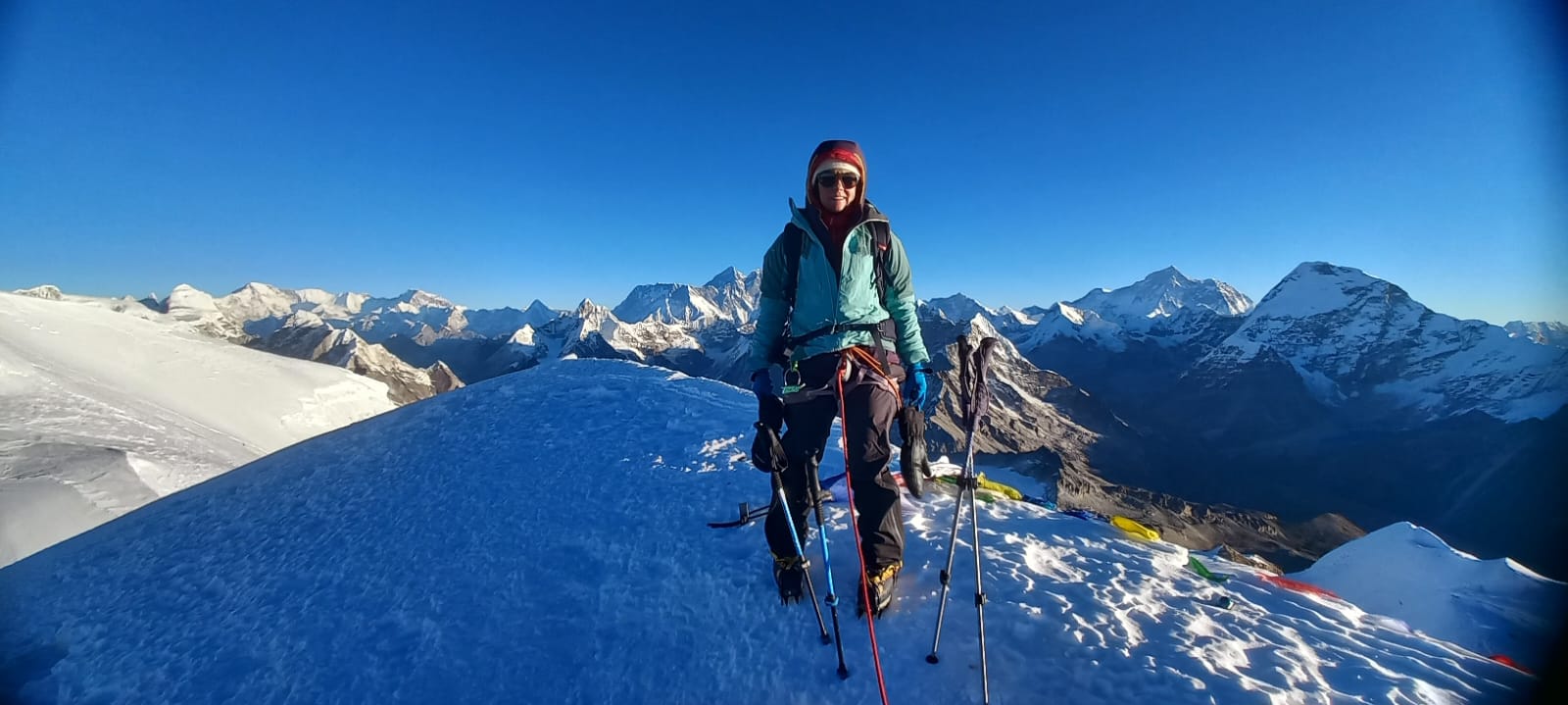
Three Peak Expedition
Embark on an unforgettable journey to the heart of the Himalayas as you conquer three majestic peaks: Mera Peak, Island Peak, and Lobuche Peak. This ultimate adventure combines technical climbing, bre...
Final Say
Climbing Mera Peak in December offers a challenging yet rewarding adventure amidst Nepal's winter landscape. With proper preparation, including physical training, gear selection, and acclimatization planning, climbers can enjoy stunning views from the summit and experience the unique cultural richness of the Everest region. Trusting in experienced Sherpa guides and embracing the journey with respect for nature and safety measures ensures a memorable and successful climb of Mera Peak, leaving adventurers with lasting memories of conquering one of Nepal's highest trekking peaks.
Mera Peak Climbing Packages
Mera Peak Summit Return By Helicopter
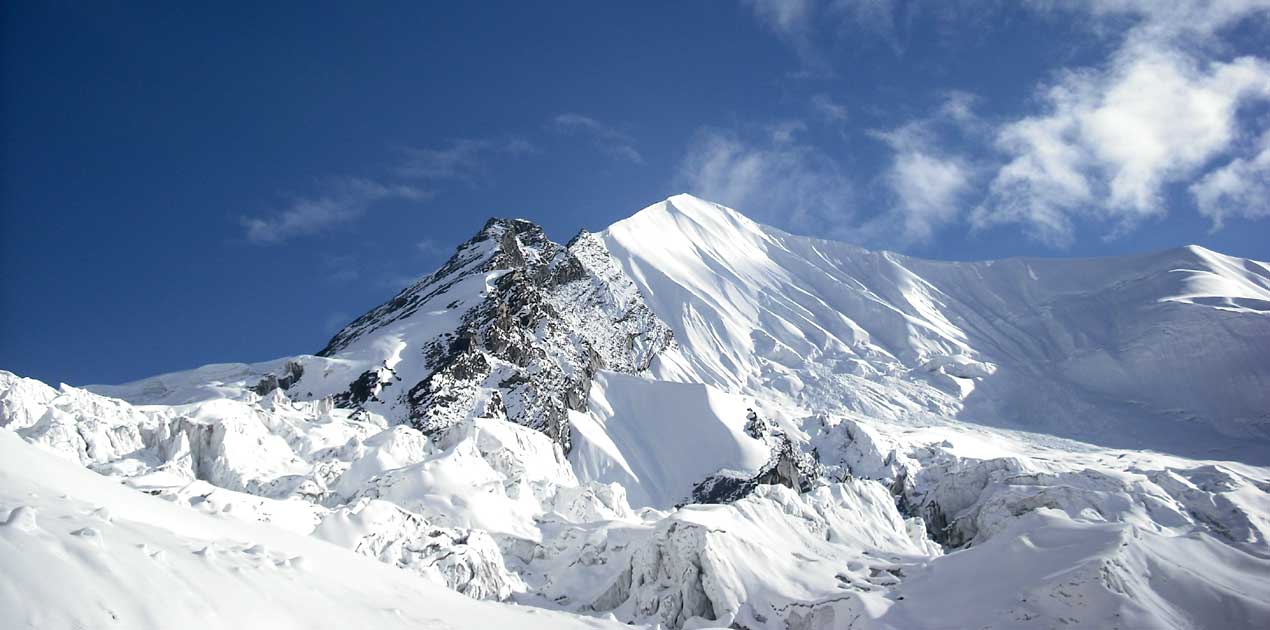
PACHERMO PEAK CLIMBING
Believe in yourself! You have what it takes to summit this beautiful peak in the remote Rolwaling district in the northeast of Nepal – near the Tibetan border. It is physically demanding, but with som...
Any Questions? Let Us Know.
Recent Posts
17th June, 2025


















